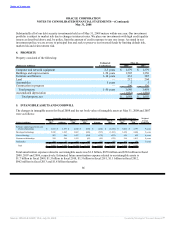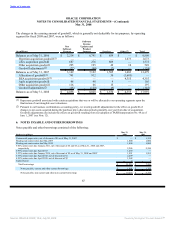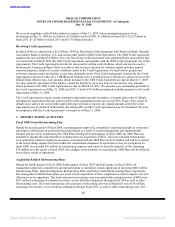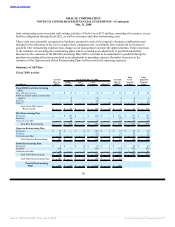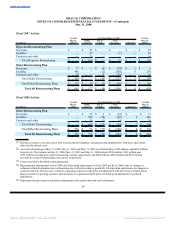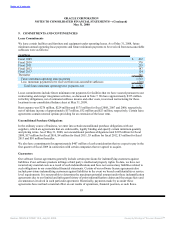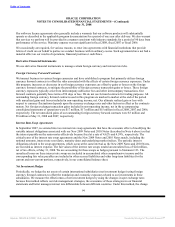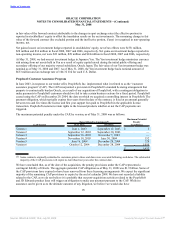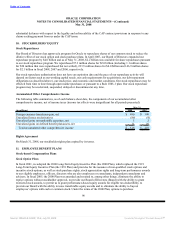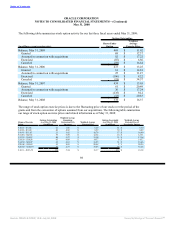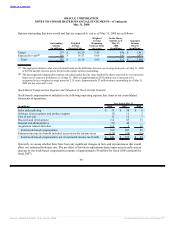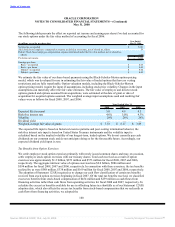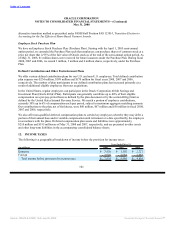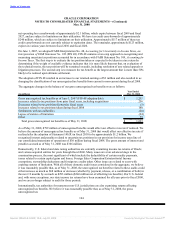Oracle 2007 Annual Report Download - page 100
Download and view the complete annual report
Please find page 100 of the 2007 Oracle annual report below. You can navigate through the pages in the report by either clicking on the pages listed below, or by using the keyword search tool below to find specific information within the annual report.
Table of Contents
ORACLE CORPORATION
NOTES TO CONSOLIDATED FINANCIAL STATEMENTS—(Continued)
May 31, 2008
in fair value of the forward contract attributable to the changes in spot exchange rates (the effective portion) is
reported in stockholders’ equity to offset the translation results on the net investments. The remaining change in fair
value of the forward contract (the excluded portion and the ineffective portion, if any) is recognized in non-operating
income, net.
Net gains (losses) on investment hedges reported in stockholders’ equity, net of tax effects were $(53) million,
$28 million and $14 million in fiscal 2008, 2007 and 2006, respectively. Net gains on investment hedges reported in
non-operating income, net were $23 million, $28 million and $24 million in fiscal 2008, 2007 and 2006, respectively.
At May 31, 2008, we had one net investment hedge in Japanese Yen. The Yen investment hedge minimizes currency
risk arising from net assets held in Yen as a result of equity capital raised during the initial public offering and
secondary offering of our majority owned subsidiary, Oracle Japan. The fair value of our Yen investment hedge was
nominal as of May 31, 2008 and 2007. As of May 31, 2008, the Yen investment hedge had a notional amount of
$633 million and an exchange rate of 104.32 Yen for each U.S. Dollar.
Peoplesoft Customer Assurance Program
In June 2003, in response to our tender offer, PeopleSoft, Inc. implemented what it referred to as the “customer
assurance program” (CAP). The CAP incorporated a provision in PeopleSoft’s standard licensing arrangement that
purports to contractually burden Oracle, as a result of our acquisition of PeopleSoft, with a contingent obligation to
make payments to PeopleSoft customers should we fail to take certain business actions for a fixed period. PeopleSoft
ceased using the CAP on December 29, 2004, the date on which we acquired a controlling interest in PeopleSoft. The
payment obligation, which typically expires four years from the date of the contract, is fixed at an amount generally
between two and five times the license and first year support fees paid to PeopleSoft in the applicable license
transaction. PeopleSoft customers retain rights to the licensed products whether or not the CAP payments are
triggered.
The maximum potential penalty under the CAP, by version, as of May 31, 2008 was as follows:
Maximum Potential
Dates Offered to Customers(1) Penalty
CAP Version Start Date End Date (in millions)
Version 1 June 1, 2003 September 12, 2003 $ 3
Version 2 September 12, 2003 September 30, 2003 —
Version 3 September 30, 2003 November 7, 2003 —
Version 4 November 18, 2003 June 30, 2004 152
Version 5 June 16, 2004 December 28, 2004 728
Version 6 October 12, 2004 December 28, 2004 1,050
$ 1,933
(1) Some contracts originally submitted to customers prior to these end dates were executed following such dates. The substantial
majority of the CAP provisions will expire no later than four years after the contract date.
We have concluded that, as of the date of the acquisition, the penalty provisions under the CAP represented a
contingent liability of Oracle. The aggregate potential CAP obligation as of May 31, 2008 was $1.9 billion. Some of
the CAP provisions have expired or have been removed from these licensing arrangements. We expect the significant
majority of the remaining CAP provisions to expire by the end of calendar 2008. We have not recorded a liability
related to the CAP, as we do not believe it is probable that our post-acquisition activities related to the PeopleSoft
and JD Edwards product lines will trigger an obligation to make any payment pursuant to the CAP. While no
assurance can be given as to the ultimate outcome of any litigation, we believe we would also have
95
Source: ORACLE CORP, 10-K, July 02, 2008 Powered by Morningstar® Document Research℠



